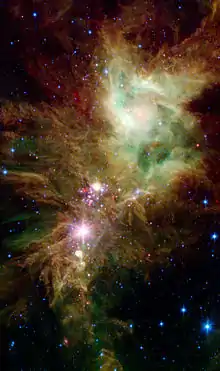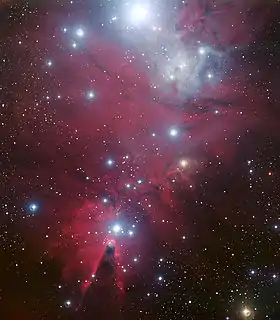NGC 2264
NGC 2264 is the designation number of the New General Catalogue that identifies two astronomical objects as a single object: the Cone Nebula, and the Christmas Tree Cluster. Two other objects are within this designation but not officially included, the Snowflake Cluster,[2][3] and the Fox Fur Nebula.[4]
| Diffuse nebula | |
|---|---|
 | |
| Observation data: J2000.0 epoch | |
| Subtype | emission nebula |
| Right ascension | 6h 41m [1] |
| Declination | +9° 53′[1] |
| Distance | ~2600 ly |
| Apparent magnitude (V) | 3.9[1] |
| Apparent dimensions (V) | 20′ |
| Constellation | Monoceros |
All of the objects are located in the Monoceros constellation and are located about 800 parsecs or 2,600 light-years from Earth.
NGC 2264 is sometimes referred to as the Christmas Tree Cluster and the Cone Nebula. However, the designation of NGC 2264 in the New General Catalogue refers to both objects and not the cluster alone.
NGC 2264 is the location where the Cone Nebula, the Stellar Snowflake Cluster and the Christmas Tree Cluster have formed in this emission nebula. For reference, the Stellar Snowflake Cluster is located 2,700 light years away in the constellation Monoceros. The Monoceros constellation is not typically visible by the naked eye due to its lack of colossal stars.
The Snowflake Cluster was granted its name due to its unmistakable pinwheel-like shape and its assortment of bright colors. The Christmas Tree star formation consists of young stars obscured by heavy layers of dust clouds. These dust clouds, along with hydrogen and helium are producing luminous new stars. The combination of dense clouds and an array of colors creates a color map filled with varying wavelengths. As seen in the photographs taken by the Spitzer Space telescope, we are able to differentiate between young red stars and older blue stars.
With varying youthful stars comes vast changes to the overall structure of the clusters and nebula. For a cluster to be considered a Snowflake, it must remain in the original location the star was formed.
When referring to this emission nebula overall, there are several aspects that contribute to the prominent configuration of a snowflake and/or Christmas tree cluster. There is a diverse arrangement of brilliant colors, and an evolving process of structure that follow star formation in a nebula.

References
- "NGC 2264". SIMBAD. Centre de données astronomiques de Strasbourg. Retrieved 9 May 2007.
- Image sig05-028 Archived 2006-09-07 at the Wayback Machine
- "Tom's Astronomy Blog » Blog Archive » The Christmas Tree Cluster". Archived from the original on 1 December 2010. Retrieved 20 December 2006.
- Nemiroff, R.; Bonnell, J., eds. (1 July 2002). "The Fox Fur Nebula". Astronomy Picture of the Day. NASA.
External links
| Wikimedia Commons has media related to NGC 2264. |
- NGC 2264 @ SEDS NGC objects pages
- NGC 2264 on WikiSky: DSS2, SDSS, GALEX, IRAS, Hydrogen α, X-Ray, Astrophoto, Sky Map, Articles and images
- Coordinates:
 06h 41m 00s, +09° 53′ 00″
06h 41m 00s, +09° 53′ 00″ - "Stars | Science Mission Directorate". science.nasa.gov. Retrieved 22 April 2018.
- O Tannenbaum, O Tannenbaum! - Astronomy Sketch of the Day, 12-25-2008
- Stellar Snowflake Cluster
- Spitzer Spots Stellar Snowflake on the 'Christmas Tree Cluster'